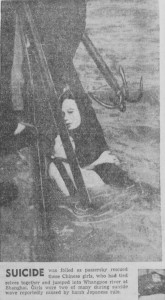Posted: July 11th, 2015 | No Comments »
George Elliston (1883-1946) was a Kentucky born journalist who had a regular column syndicated across America that occasionally included a little of her own verse. Her poetry appeared in newspapers and magazines in the U.S. and was reproduced in anthologies in France, Germany, Great Britain and China. This poem – “Peking” – appeared in 1936….
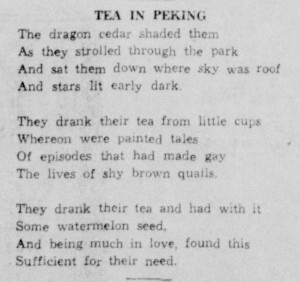
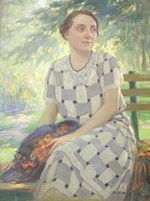
George Elliston
Posted: July 10th, 2015 | No Comments »
Earlier this year I contributed a true story of a 1907 Shanghai murder to the UK Crime Writers’ Association anthology, Truly Criminal – it’s now available in the USA…So a quick re-cap….
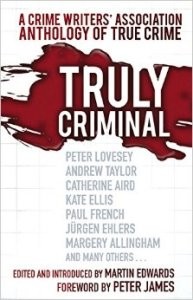
My contribution – A Murder in the Shanghai Trenches – is the true story of the 1907 murder of Eliza Shapera, a Jewish woman of dubious virtue, a prostitute, probably trafficked from Russia in the then notorious red light area of Scott Road in Hongkew, aka The Trenches. The murder was investigated by two veteran detectives of the Shanghai Municipal Police Detective-Sergeant Thomas Idwal Vaughn and Detective-Inspector John McDowell. Their investigation took them into the heart of The Trenches and the brothels of the area and their suspects included a mysterious Indian pimp, two Chinese house thieves and various Chinese and European prostitutes. It was a major cause celebre at the time and highlighted the dark underbelly of turn of the century Shanghai, a world of vice and crime that was to make the city notorious as it grew and festered throughout the first half of the twentieth century up to the Second World War. I’ve based my reinvestigation of the case on the newspaper articles and court documents of the time and, I think, that even after more than a century we can now see quite clearly who killed Eliza, and why they did it….
I’ve added some additional background on old Shanghai’s districts of sin and murder as well as an excerpt from the piece here on the Los Angeles Review of Books China blog and an interview on the case of Eliza Shapera and writing about old Shanghai on RTHK Radio 3 in Hong Kong…..
Posted: July 10th, 2015 | No Comments »
A while back I posted on the new edition of Ann Bridge’s classic novel of sojourning foreigners in interwar Peking, Peking Picnic. Due entirely to my own ignorance I erroneously suggested that Bridge had only written two novels dealing with China – Peking Picnic and The Ginger Griffin. Wrong! Thanks to a sharp eyed, and very well read, China Rhyming reader who pointed out that I had missed Bridge’s novel Four Part Setting. I’m afraid I don’t know the novel – though obviously will read asap – meanwhile here’s the Kirkus Review from October, 1939…

This book returns Ann Bridge to her earlier champ de combat, the Anglicized China of Peking Picnic and Ginger Griffin. It is in a sense a more mature book, a more astute one, limiting itself to the gently satirical dissection of five rather minor people. However, it lacks the plot sense of her earlier books — and this may be a stiff hurdle. The five are headed by Rose, a volatile, pretty, but integrally washy young woman, in flight from an un-understanding husband. Staying with her two cerebral cousins, she meets a happy amorist with whom she has an affair, and Hillier, a chronic cynic. The five take a long walking trip through North China, and their romantic inclinations jell, Rose turning from Henry to her cousin Antony, Hillier intrigued by the other cousin, Anastasia. And another reversal in Rose’s amatory progress by the close. Intelligent, perforating without acridity, but extremely conversational for so long a book, and Miss Bridge may be talking herself out of a very solid audience.
Posted: July 9th, 2015 | No Comments »
This picture from July 1939 is interesting – while Japanese anti-British demonstrations were a bit of a way of life in Shanghai and Tientsin after the war started in ’37, this picture shows the involvement in a demonstration of Chinese living within the Japanese concession (perhaps coerced, paid to attend?) and White Russian activists (probably in the pay of the Japanese or part of one of the various pro-fascist White Russian grouplets) – the slogan says “Knock Down Britain”. The primary gripe seems to be Britain’s support for Chiang Kai-shek and the Nationalists against the Japanese. Quite what uniform the White Russian is wearing is somewhat lost on me?

Posted: July 8th, 2015 | No Comments »
“It is not history, but it is a hoot”, one reviewer wrote – and quite true. Sky Atlantic’s Fleming (which has been around for a while but I only just round to seeing it) was great fun. If there are one or two people from the twentieth century it would be excellent to be then Ian Fleming must be one of them – topped only perhaps (and certainly so for all China Rhymers) by his older brother Peter.
So it would be remiss of me not to note the presence of China sojourner, explorer and commentator Peter Fleming (the older brother, played by Dominic Cooper) in the show. Of course for many years, before the war, Peter was the Fleming everyone knew – a standard pin-up for the girl’s sixth form. His travels in China are legendary and chronicled in One’s Company and News From Tartary. Fleming starts with the two brothers travelling through Europe on a train and Peter being spotted and asked to sign a book – “ho0w are you?” asks his female admirer to which, Peter (played by Rupert Evans) utters the (to China Rhymers anyway) immortal line,”I’m just back from Manchuria.”
It is also true, as mentioned in the programme, that Ian Fleming was about to be offered the post of Shanghai correspondent for Reuters in 1939 after he resigned from the Berlin post. He didn’t take the job. In the programme he gives his reason as being that “the salary wouldn’t have even covered my opium bill.” A good line but I’m not sure it’s got any basis in history.
Peter comes over as a bit of a mummy’s boy and the less eccentric, less anti-authoritarian brother. I’m not sure how accurate that is either, but the show’s about Ian so plays up his playboy creds. Still, Peter traveled through Brazil, Russia and China and had plenty of adventures as well as marrying a movie star (Celia Johnson). However, if you believe the achingly funny portrayal of Peter in Auden & Isherwood’s 1939 Journey to a War then perhaps there’s some truth in it.
BTW: there’s a profile of Peter Fleming here that I wrote for the Audible audiobooks website some time back…..

Dominic Cooper as Ian Fleming

Rupert Evans as Peter Fleming

The real Peter in uniform
Posted: July 7th, 2015 | No Comments »
Just how much did the factory girls of 1939 Shanghai earn? Amazingly just $15 for three years work!….
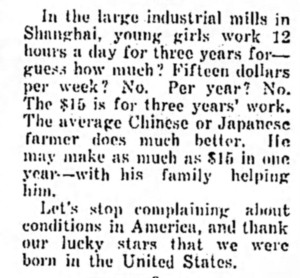
Posted: July 6th, 2015 | No Comments »
Robert Nield’s China’s Foreign Places – now out and highly recommended as a history of the treaty ports…
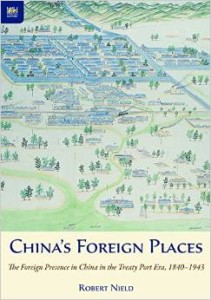
During the nineteenth and early twentieth centuries, the imperial powers–principally Britain, the United States, Russia, France, Germany and Japan–signed treaties with China to secure trading, residence and other rights in cities on the coast, along important rivers, and in remote places further inland. The largest of them–the great treaty ports of Shanghai and Tientsin–became modern cities of international importance, centres of cultural exchange and safe havens for Chinese who sought to subvert the Qing government. They are also lasting symbols of the uninvited and often violent incursions by foreign powers during China’s century of weakness. The extraterritorial privileges that underpinned the treaty ports were abolished in 1943–a time when much of the treaty port world was under Japanese occupation. China’s Foreign Places provides a historical account of the hundred or more major foreign settlements that appeared in China during the period 1840 to 1943. Most of the entries are about treaty ports, large and small, but the book also includes colonies, leased territories, resorts and illicit centres of trade. Information has been drawn from a wide range of sources and entries are arranged alphabetically with extensive illustrations and maps. China’s Foreign Places is both a unique work of reference, essential for scholars of this period and travellers to modern China. It is also a fascinating account of the people, institutions and businesses that inhabited China’s treaty port world.
Posted: July 5th, 2015 | No Comments »
On the last day of 1940 these Chinese women attempted suicide by jumping into the Whangpoo River (Huangpu River) tied together. Passersby pulled them out and they did not drown. The newspaper speculated that the harsh life in Shanghai since the 1937 Japanese invasion was probably to blame – and maybe it was (stagflation, hunger, shortages, unemployment, dislocation, death, disease – take your pick?) but maybe they had another story…who knows! It’s certainly quite a haunting picture.
